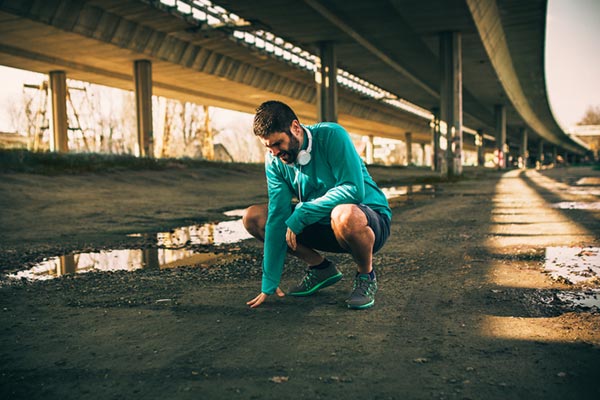You’re trying to do your body a solid, only to be unduly rewarded with a gut-wrenching stitch when running – as if your training isn’t painful enough.
When a stitch is a regular thing, you’ll probably find yourself questioning your methods. Did you eat too soon? Go too fast too early? When did you last go to the restroom?
Before you unearth the answer, you need to know why this problem even exists.
What causes a stitch when running?
Trouble is, no one is 100% sure how stitches are caused. It’s thought to be poor blood supply to your diaphragm area which causes it to cramp, or food weighing down your diaphragm causing it to pull down and strain your abdominal cavity and ligaments.
Whatever causes it, it feels like you’ve copped a shank to your love handles for their sins of existing. When it strikes, your first action should be to stop and stretch.
If the stitch is on your left side, raise your right arm overhand and place it at the back of your head then lean away from the pain for 30-60 seconds, and vice-versa.
What doesn’t work for getting rid of a stitch when running?
A study from the University of Otago found that attempting to relax abdominal muscles or increasing the impact of your foot strike had little effect in relieving you of your unwanted, painful training partner.
The same researchers also discovered that stitches cannot be readily explained by mechanisms involving digestion-induced changes in blood flow, as was previously thought.

So, not eating or drinking is likely not the answer to a pain-free run and would likely negatively effect your performance.
Still, eating on a full stomach probably isn’t the most comfortable way to go about your run.
Getting your nutrient timing right can give you the perfect crossover between comfort and fuel for your run.
5 ways to get rid of a side stitch when running
1 Prepare for your run properly
A paper in Sports Medicine found to avoid them, you pretty much need to do all the prep you’d normally before any exercise: drink plenty of water, stop eating two hours before training and avoid sugary drinks which draw the fluid out of the spaces between your organs.
2 Make your core as strong as your legs to avoid a stitch
Often, runners experience stitches without changing anything in their diet or training regime, and this can be because they’ve become stronger and more stable in their legs, yet their core has become comparatively weaker, causing excessive movement.
This is when it’s worth stabilizing your abdominal region with at least two core workouts a week, each lasting 10-15 minutes and focusing on your obliques using moves such as side planks.
This will increase your trunk stability so your gut isn’t flopping around like a piece of wet linguine.
3 Breathe through pursed lips to purge your stitch
A study in the journal Medicine and Science in Sports and Exercise found that pursing your lips and taking huge breaths with increased lung volume alleviated a side stitch caused by running almost immediately.
It’s not quite known why this is, but does anybody really care if it works? If it gets rid of a potentially workout-stopping stitch, you won’t hear many runners complaining.

4 Belt up to resolve the runners side cramp
This is probably one of the stranger ways to alleviate a stitch according to the same study above. But bringing a belt with you on your journey could be a savior.
When the dreaded stitch hits, stopping and tightening a belt around the waist alleviated the runners stitch within seconds.
A strange method and one has to wonder where the researchers got the idea. The final tip might answer that question…
5 Stomach cramps while running? Bend into them
Bending forward while tightening your abdominal muscles was also found to relieve a stitch very swiftly.
Strangely, bending away had no effect on the intensity of the stitch at all.
This seems to support the theory that a stitch when running occurs because the fluid in the gut tugs on visceral (organs) ligaments.
Obviously, bending forward would relieve some of that tug on the organs where as stretching away from the pain would only increase the pull on visceral ligaments.
This also makes sense as to why tightening a belt would be an effective way to get rid of a stitch.
It’s logical that a belt prevents expansion of your gut (why do you unbuckle your belt to make room for more holiday dinner? To expand and make more room) and therefore relieves pressure on the ligaments around the organs.
Hopefully these five tips will eliminate the dreaded stitch or any other type of cramping from your running game.
The good news? Nobody has ever died from a stitch, even if it feels like you might come close.
Hitting the wall when running, though? Now that’s a different beast entirely and will require another approach.
If none of these remedies don’t work, you may want to think about switching to a different form of cardio that doesn’t suffer from this problem, like cycling.
The downhills are way more fun anyway.
For more content on getting rid of a stitch when running, nutrition, and workouts, get TRAIN magazine direct into your inbox every month for free by signing up to our newsletter







